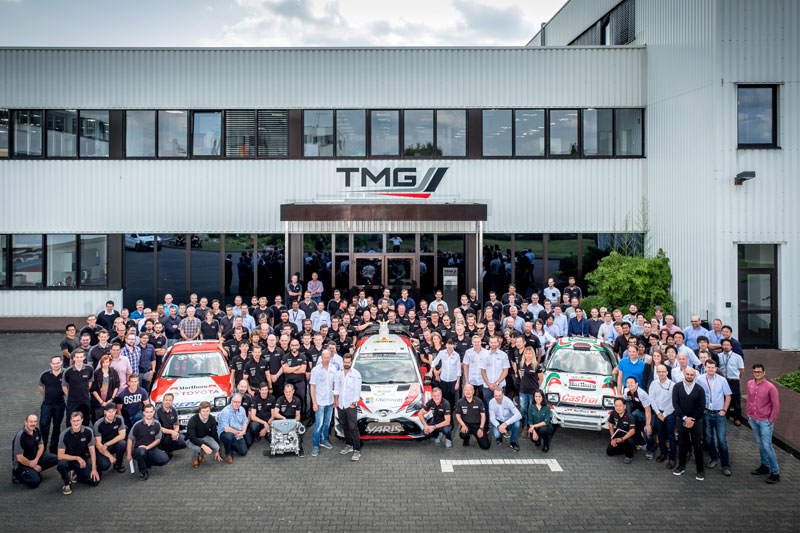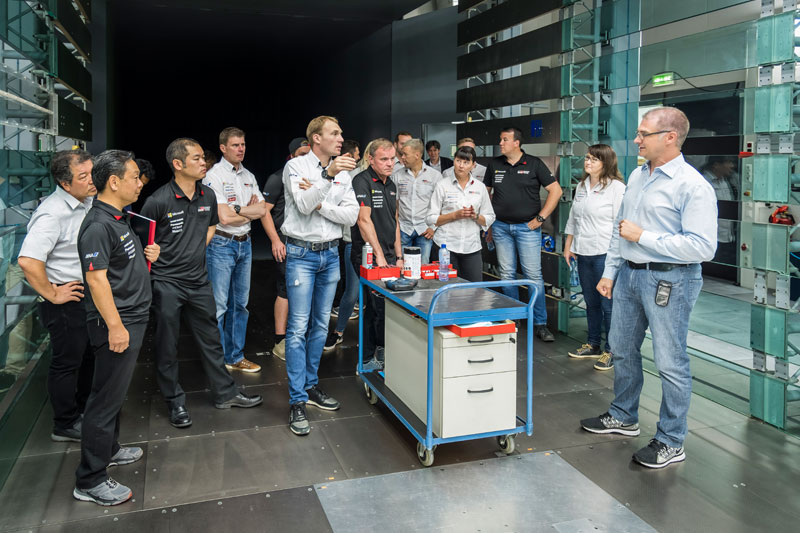RALLYE DEUTSCHLAND

The Yaris WRC evolves into a rally car that can compete at the top at tarmac rallies
Hänninen finishes fourth at the challenging Rallye Deutschland
Rallye Deutschland was the third tarmac rally of the season, and demanded a combination of power from both car and driver. The genuine SSs began on Day 2 of the rally, on August 18. The courses used in the rally were full of variety; on this day, the roads that crossed the vineyards stretching across the banks of the Moselle River provided the highlights. Originally established for farming, the roads that passed through the vineyards were narrow and, after a number of cars had passed, the mud and gravel on the insides of the corners sprayed out, and the road began to resemble a gravel course. Then, when the rains fell, wet mud from the vineyards spilled out onto the course, making the surface conditions even worse. Since the conditions were constantly changing, it was difficult for the drivers to predict what sort of surfaces lay beyond the next corner.
Many drivers veered off course on the SSs held within the vineyard, and TOYOTA GAZOO Racing WRT’s Juho Hänninen was one of them. Fortunately, his Yaris WRC suffered minimal damage and Hänninen was able to continue on without issue. He was, however, made aware of the difficulties presented by the German roads. Hänninen competed in Rallye Deutschland once in 2011, but he had an overwhelming lack of experience for such a unique course. For this reason, after going off track, Hänninen focused on driving steadily for the remainder of the SSs, gradually increasing his pace as he gained in experience. With course conditions made significantly more difficult due to rain, Hänninen’s approach paid dividends, and he finished Day 2 in 6th in the overall standings.
Hänninen records the fastest time on the longest SS of the rally
The Baumholder Military Training Area played host to the majority of Day 3’s SSs, and the drivers were faced with a unique tarmac course—significantly different to the previous day’s vineyard roads. The majority of roads within the training area were hardened with concrete. As a consequence, tire grip in dry conditions was superior to that on standard paved roads. When wet, however, the concrete surface became extremely slippery, and vehicle control increased in difficulty quite drastically. In addition, the sides of the roads were lined with “hinkelsteins,” large concrete blocks used to prevent tanks from leaving the road. Any cars hitting these blocks were liable to suffer heavy damage. In past rallies, many drivers became fodder for the hinkelsteins and were forced to retire. For this reason, a number of drivers held a dislike for the Baumholder stages.
For Hänninen, the Baumholder stages were an almost unknown entity. However, he completed Panzerplatte 1, the longest stage of this year’s rally, faster than any other driver. While it is true that correct tire selection played its part, Hänninen’s speed was unrivalled. He guided the Yaris WRC smoothly from start to finish, finishing the 41.97 km-long stage in a time of 24 minutes 39.7 seconds. In recording the fastest time, he beat competitors with much greater experience of the course. With his victory on Panzerplatte 1, Hänninen gained confidence in the performance of the Yaris WRC on tarmac, and continued to drive cleverly, combining speed and stability, in the subsequent stages.
Hänninen continued to maintain outstanding form in the afternoon stages. However, on Panzerplatte 2—a rerun of the stage he won in the morning—his dampers were damaged by some sort of impact and he was forced to drop his pace. Hänninen drove two more SS with problematic dampers and lost significant time. Yet, he still managed to finish Day 3 in 5th position overall, and approached the final day with the aim of gaining further places.
Hänninen goes on the attack and secures 4th place in the overall standings
The final day had just four stages, and each stage was short; this meant there would be few chances for Hänninen to gain places. However, the Finn trusted the Yaris WRC completely, went on a full-blooded attack on SS18, the first stage of the final day, and succeeded in recording the best time. He overcame the 4.2-second deficit to the driver in 4th, and completed a career-best result at a tarmac rally with 4th place in the overall standings. Hänninen looked delighted as he summarized his performance: “Apart from running off course on Day 2, it was an extremely satisfactory rally for me. The Yaris WRC is easy to control even on tarmac, so I was able to drive these difficult courses with confidence. At rallies like Rallye Deutschland which feature a succession of tricky roads, the key is how much you can trust your vehicle. The Yaris WRC has evolved greatly since the Tour de Corse in France, the previous tarmac rally, and its handling in particular has improved. I believe it has now developed into a car that can compete at the top even on tarmac.”
Lappi overcomes difficulties to make significant progress
Jari-Matti Latvala was also satisfied with the state of his Yaris WRC, and at one point he was 5th in the overall standings. However, after initially being delayed with an ignition-system issue, then suffering a puncture on Day 3, he fell out of contention and finished the rally in 7th place. Team Principal Tommi Mäkinen pledged to enhance both the reliability and performance of the vehicle for the final three rallies: “Jari-Matti’s car has had issues for three rallies in succession—I am truly sorry for this. All of the issues have been different, but we must thoroughly investigate the causes and prevent them from reoccurring. If he hadn’t suffered these problems, Jari-Matti would no doubt have been on the podium, so it is very disappointing. Nevertheless, we now know that the Yaris WRC is highly competitive even at tarmac rallies, and this is extremely positive for the team.”
With his win at the preceding Rally Finland, Esapekka Lappi had shown great improvement. However, he was driving the German roads in a World Rally car for the first time, and it turned out to be more difficult than he had imagined. Last year, Lappi competed in and won the WRC 2 class of Rallye Deutschland in the R5. However, the R5 was much slower than the Yaris WRC, and Lappi was initially bewildered. On Day 2, he damaged his vehicle’s suspension while running off course, and retired for the day. Then, after taking to the course on Day 3 in a repaired vehicle, he was unable to achieve the times he wanted and expressed his disappointment, saying: “I’m attacking 100 percent, but my times are slow. I’m worried because I don’t know why.” In order to make as much progress as possible, at the end of Day 3 Lappi thoroughly analyzed his performance data with the team’s engineers. As a result of their efforts, the team was able to find a solution, and on the final day Lappi recorded one fastest time and one second-fastest time, so concluding the rally in good shape.
Lappi was full of praise for the team engineers: “When exiting tight corners, I was stepping on the accelerator too suddenly, and this was causing the slow times. The Yaris WRC engine has high torque at low rpms, and we learned from the data that I was causing the wheels to spin. So, on Day 4, I changed my driving style and stepped on the accelerator in a much more gentle fashion—the car generated steady driving force, and my times improved. Thanks to the cooperation of the engineers, I was able to resolve my problems.”
The WRT team visits TMG, which oversees engine development for the Yaris WRC
TMG (Toyota Motorsport GmbH), which is in charge of engine development for the Yaris WRC, is situated in Cologne, close to the region that hosted Rallye Deutschland . For the duration of the rally, large numbers of TMG employees visited the course and service park to show their support. The day after the rally finished, the entire TOYOTA GAZOO Racing World Rally Team—including the drivers and co-drivers—visited TMG. There, they deepened their relationships with the TMG employees, who they usually have little chance to meet. TMG not only develops engines for the Yaris WRC—it is also the development base for the Toyota TS050 Hybrid, which competes in the FIA World Endurance Championship. The drivers and co-drivers were shown around the TMG factory, and were able to carefully observe the development process for a completely different rally car. It was an extremely meaningful day for the team.
Hänninen, who performed so admirably at Rallye Deutschland, spoke of his visit to TMG: “We don’t normally have the chance to meet employees unless they work on engine development for the Yaris WRC. So, it was really good to actually meet and speak to the people at TMG who are not engaged in rally work. In addition, my motivation increased even more after seeing the factory where they make the Yaris WRC engines. The new engine that was introduced at Rally Finland is even easier to operate and even more powerful. In Germany, too, the engine’s power at low to medium rpms and its responsiveness to acceleration had improved, and the engine was really easy to operate even on poor surface conditions. I want to say thank you to the employees in Cologne who have developed such an outstanding engine for us.”
Latvala renews his focus after seeing older generations of Toyota rally cars
Latvala participated in the factory tour with more enthusiasm than any other team member and asked countless questions of engineers in every department. He lost track of time as he looked in great detail at the old rally cars on display inside the factory. He paid particular attention to the original Celica GT-Four, which he himself also owns, opening the hood and carefully checking all the parts inside. He said: “Today was a fantastic day for me. I was able to speak to the TMG employees a lot, and I went on a splendid tour of the facilities. I also saw many of the rally cars that established Toyota’s legacy, and it renewed my feeling of pride at being able to compete in the WRC as part of the Toyota team.”
Despite being concerned about the departure time of his flight to Finland, Latvala enjoyed speaking to the TMG employees about rallying until the very last minute and looked reluctant to leave the factory.
RESULT
| Pos | Driver | Co-Driver | Vehicle | Time |
|---|---|---|---|---|
| 1 | Ott Tanak | Martin Jarveoja | Ford Fiesta WRC | 2h57m31.7s |
| 2 | Andreas Mikkelsen | Anders Jaeger | Citroen C3 WRC | +16.4s |
| 3 | Sebastien Ogier | Julien Ingrassia | Ford Fiesta WRC | +30.4s |
| 4 | Juho Hänninen | Kaj Lindström | Toyota Yaris WRC | +1m49.2s |
| 5 | Craig Breen | Scott Martin | Citroen C3 WRC | +2m01.5s |
| 6 | Elfyn Evans | Daniel Barritt | Ford Fiesta WRC | +2m03.4s |
| 7 | Jari-Matti Latvala | Miikka Anttila | Toyota Yaris WRC | +3m58.2s |
| 8 | Hayden Paddon | Seb Marshall | Hyundai i20 Coupe WRC | +4m32.4s |
| 9 | Armin Kremer | Pirmin Winklhofer | Ford Fiesta WRC | +10m19.4s |
| 10 | Eric Camilli | Benjamin Veillas | Ford Fiesta R5 | +10m44.3s |
| 21 | Esapekka Lappi | Janne Ferm | Toyota Yaris WRC | +18m05.2s |









